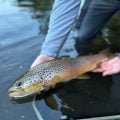Euro Nymphing: Tenkara’s European Cousin

One of New York comp angler Loren Williams’s fly boxes, with an array of salmon egg, worm, and nymph patterns.
Tenkara bears a striking resemblance to one of the most popular trends in mainstream fly fishing: Euro nymphing. The method was developed by European competition fly fishers to maximize the number of fish they catch while complying with the rules of the Fédération Internationale de la Pêche Sportive Mouche or, in English, the International Sport Flyfishing Federation, usually referred to as FIPS Mouche.
The key elements are long rods, short lines held high off the water, and simple flies that suggest aquatic insects in a general way.
National teams in Poland, France, Spain, the Czech Republic, and other European countries have competed for decades on a circuit that culminates in a World Championship, compete with an Olympics-style opening procession and medal stand. American fly fishers joined the circuit in a serious way in the mid-2000s.
In the United States, local and regional competitions serve as qualifiers for a National Championship, which picks the team that will go to the World tourney.
The very idea of competitive fly fishing is mildly controversial among anglers. Some see it as a corruption of a contemplative pursuit. But for those who enjoy it, especially younger anglers, competing adds a new level of interest to the fishing.
At least in the United States, competition anglers receive no pay or subsidy, except perhaps a small sponsorship here or there. They fish on their own time and pay their own way, often driving hundreds of miles to competitions and staying in motels. The traveling and socializing with their fellow competitors is all part of the fun, but it’s also a significant effort and expense. So you can be sure these guys and gals are going to use the techniques that are most likely to catch fish.
I’ve hung around a couple of local competitions as an observing journalist. They’re fun. US competitors have set up various kinds of competitions, and even established a team-based league that sanctions events, mainly in the eastern part of the country.
Despite the fact that anglers compete as individuals and members of teams, they fish individually, much as they would purely for their own fun. The difference is there’s another person standing by with a clipboard, recording their catches, making sure they follow the rules, and letting them know when their time slot, usually three hours, is up.
They fish on public water, and they don’t have it to themselves—recreational anglers can and do fish alongside them. For that matter, the water is liable to be used by kayakers or tubers, too, which adds a layer of challenge to the fishing. Each angler is assigned to a “beat,” usually a couple hundred yards of stream, and every fish caught above a certain size is recorded for their score.
Many comps, especially the larger regional ones, also have beats on lakes, which are fished from shore or even from boats. But it’s always trout fishing, and it’s mostly stream fishing.
Within that category, the anglers sometimes use floating dry flies to catch fish feeding at the surface, and that kind of fishing usually involves picking a fly that looks as much as possible like the real ones. Comp fishers also sometimes fish with streamers, sunken flies that look like small fish, or other calorie-rich critters like crayfish or leeches, made to “swim” well below the surface.
But more than anything else, competition fishers endeavor to catch trout with nymph flies, which are meant to look like the underwater life stage of mayflies, caddisflies, or stoneflies.
Flies that Win Trophies
Lots of fly fishers use nymphs, and for the same reason the comp anglers do—they are very effective fish catchers. Nymphs are fished deep in the stream, down in the depths where trout hang out most of the time. They are meant to drift along with the current, making them easy for trout to grab as a quick snack.
The European comp anglers began devising nymph patterns with particular characteristics. Instead of being fitted with “hackle” feather fibers meant to simulate legs or tails, the Euro nymphs are sleek, usually just a body, often tapered, and made in such a way to look segmented, like many insects.
The nymphs are designed this way to help them sink readily. The more quickly they get down to the depth where the fish are holding, the better the chance of catching a fish. The Euro nymphers decided this tactical advantage was more important than any attempt at imitating specific insects.
Often the Euro nymphs have a metal bead at the front of the fly. Bead-head flies existed before comp anglers began using them, but they became important to the competitors for a couple of reasons. One is that the metal bead adds to the fly’s sink rate. In recent times, many anglers have switched from beads made of tin to ones made of tungsten, which are considerably heavier. FIPS Mouche rules forbid using sinkers attached to the line, so any sink weight needs to be built into the fly itself.
The other advantage of a bead-head fly is that the bead adds a little flash. It increases the fly’s visibility and catches the trout’s attention.
Euro nymphers also borrowed a page from the bait-fisher’s book by using jig hooks for many patterns. Flies tied on these hooks ride with the hook point up instead of down, which reduces the possibility of snagging on rocks and branches lying on the bottom of the stream, and usually results in a secure upperjaw hookup.
Heavy Flies, Long Rods, and Short Lines
When the situation calls for fishing a floating fly, comp fishers often employ the standard fly-fishing setup, with a thin clear leader 9 to 12 feet long at the end of a floating fly line. But for their nymph fishing, they developed a radically different rig.
A very common recreational-fishing method of fishing nymphs is to use a strike indicator, which is basically a little bobber, usually made of foam, from which the nymph is suspended on a length of leader about equal to the depth of the water being fished. The angler watches the indicator float and sets the hook when it is pulled underwater by a fish that has grabbed the nymph.
Again, FIPS Mouche rules require a workaround; strike indicators are not permitted in competitions. So Euro nymphers, especially French and Spanish anglers, essentially jettisoned the traditional fly line-and-leader arrangement.
They adopted rods as long as 11 feet, compared to the traditional 9-foot fly-rod length.
They also began using very long leaders. In fact, they often fished only with their leaders. Comp anglers still had floating fly lines on their reels, but often the line never even made it into the cast. The leaders could be around 20 feet long, and the anglers used them to fish water as close as right under the rod tip and seldom farther than twenty feet away from where they stood.
Euro nymphers make quick, flicking casts, dropping the nymph into every pocket that could conceivably hold a fish. The rod is high and the line is tight, with little or no slack. Tournament fly fishers did not invent tight-line nymphing, also known as high-stick nymphing, but they elevated it to an art.
Comp anglers “fish with their feet.” They run their nymphs through each likely spot two or three times, and if there is no bite, move onto the next spot. Each pocket of “soft,” current-free water behind a midstream rock, or the “seam” between a swift current and a slower current alongside, would be checked for fish. Sometimes the angler sees his or her line dart, or quiver, or pause, indicating a fish has taken the fly. Sometimes they feel a tug before they see anything. Any interruption of the progress of the line downstream during the drift prompts the angler to set the hook.
This is very similar to tenkara fishing, with one key difference. Authentic Japanese tenkara fishing uses unweighted wet flies, which have similarly simple construction but do have a hackle of feather fibers at the front of the fly, and fishes them shallow, usually just a few inches below the surface. Nymphs are designed to be fished deep.
It is true that some Japanese tenkara fishers like to use weighted nymphs, for the same reason as their peers in Europe and America, both competitors and recreational anglers.
American anglers quickly recognized how effective tenkara rods could be for presenting nymphs. I sure did. The first time I caught a trout with a tenkara rod, the fly I was using was a heavy, olive green Euro-style grub pattern. I have caught hundreds of trout nymphing with a tenkara rod since then.
The willowy action of a tenkara rod poses a bit of a problem when using a weighted nymph. The rod’s flexibility makes it a little more difficult to set the hook of a fly drifting three or four feet deep. Some tenkara rod models, however, have somewhat stiffer actions, specifically to make them more suitable for nymphing, both casting and hook setting. The manufacturer will usually make that clear.












